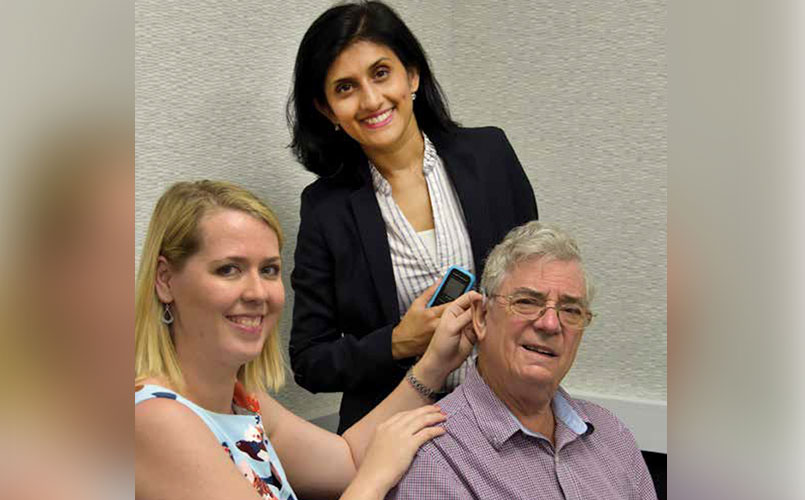 Dec
17
2015
Dec
17
2015
New paradigms in managing Meniere’s disease
Original article published in the San Doctor Winter 2015 available here.
Meniere’s disease is a disorder characterised by disabling attacks of recurrent vertigo, fluctuating hearing loss, tinnitus and aural fullness. Despite having an estimated prevalence of 46-200 per thousand patients1, the etiology remains poorly understood. The disease classically has a disabling and destructive effect on the underlying hearing and balance function.
If patients experience “drop attacks” or tumarkin crisis (marked by a sudden sense of falling), or frequent unremitting disabling vertigo uncontrollable by other means, ablative treatment of balance such as intratympanic gentamicin or surgical labyrinthectomy may be considered2. Though this brings permanent cure from vertigo, it also ablates hearing in that ear.
In this setting the application of Cochlear Implant technology has created a lot of interest as it gives new hope for these patients to regain their ability to hear. Cochlear implantation (CI) has been used for rehabilitation of profound hearing loss for over two decades and its role continues to expand. However, in the setting of labyrinthectomy, many consider CI a contraindication and especially so if there is a significant time delay in implantation following labyrinthectomy.
This is because there is concern that following labyrinthectomy the cochlea may develop scarring, ossification and obliteration precluding subsequent cochlear implantation. Though successful case reports of delayed implantation have been reported6, a relatively new proposal is to consider simultaneous implantation at the same time as labyrinthectomy.
Cochlear implant candidacy changes
A large proportion of patients seldom fulfilled CI candidacy criteria under previous guidelines which required bilateral profound hearing loss (Figure 1).
With improved technology, less traumatic electrodes, soft surgical techniques and better understanding of different hearing loss patterns, candidacy for CI has now been extended to include single sided hearing loss (Figure 2). CI in single sided hearing loss has shown significant benefit in tinnitus suppression. It has also shown a tremendous improvement in the ability to localize sound and speech understanding when there is background noise.
CI is now considered the superior alternative to other hearing solutions for single sided hearing as it the only solution that restores the ability of the patient to hear in their deaf ear and acquire directionality of sound.
CI candidacy impact on Meniere’s management
This revolutionary change in Cochlear Implant candidacy has had a great impact for many Meniere’s sufferers as a large proportion of them have unilateral hearing loss either due to the disease process or due to ablative treatments. It means that now their hearing rehabilitation can be carried out independent of the hearing status in their other ear. Therefore, patients who are candidates for labyrinthectomy can be considered for CI at the same time. This circumvents the risk of cochlear ossification and failure to implant which is a risk patients would previously be exposed to as they would have to wait to lose hearing in their contralateral ear to fulfil candidacy for implantation.
A current multicenter study being conducted in Sydney by the author assessing outcome of CI in Meniere’s disease, shows excellent hearing outcome in these patients. CI hearing outcome in patients with labyrinthectomy are similar to outcome of patients without a labyrinthectomy. Thus a labyrinthectomy should not be considered a contraindication for CI.
If the natural course of Meniere’s disease has destroyed the patient’s natural hearing in one or both ears or their vertigo control meant that they needed ablative treatment which destroys the hearing, patients can attain good hearing restoration with CI, provided of course that the patient is motivated and had good postoperative audiological rehabilitation which is crucial for the success for any CI.
Original article available here.
References:
- Minor LB, Schessel DA, Carey JP. Ménière’s disease. Curr Opin Neurol 2004;17:9–16
- Zwolan TA, Shepard NT, Niparko JK. Labyrinthectomy with cochlear implantation Am J Otol. 1993; 14: 220-3
- Osborn HA, Yeung R, Lin VY. Delayed cochlear implantation after surgical labyrinthectomy. The Journal of laryngology and otology. 2012; 126: 63-65.
- Wareing M, O’Connor AF. The role of labyrinthectomy and cochlear implantation. Ear Nose and Throat Journal. 1997; 76 (9): 664-9.
- Chen D, Linthicum JR and Rizer F. Cochlear histopathology in the labyrinthectomised ear: Implicatations for Cochlear Implantation. Laryngoscope. 1988; 98: 1170-72.
- Lustig L, Yeagle J, Niparko J and Minor L. Cochlear Implantation in patients with Bilateral Meneire’s Syndrome. Otology and Neurotology.2003; 24: 397-403
- Firszt JB, Holden LK, Reeder RM et al. Auditory abilities after Cochlear Implantation in Adults with Unilateral Deafness: A pilot study. Otology and Neurotology. 2012; 33: 1339-1346
- Amoodi HA, Mick P, Shipp DB et al. The effect of Unilateral Cochlear Implantation on the Tinnitus Handicap Inventory and the Influence on Quality of Life. Laryngoscope. 2011; 121: 1536-40.
- Kim DK, Bae SC, Park KH et al. Tinnitus in patients with profound hearing loss and the effect of cochlear implantation. Eur Arch Otorhinolaryngol. 2013; 270: 1803-08.
- Tavora-Vieira D, Marino R, Krishnaswamy J et al. Cochlear Implantation for unilateral deafness with or withour tinnitus: A case series. Laryngoscope. 2013; 123: 1251-55.




